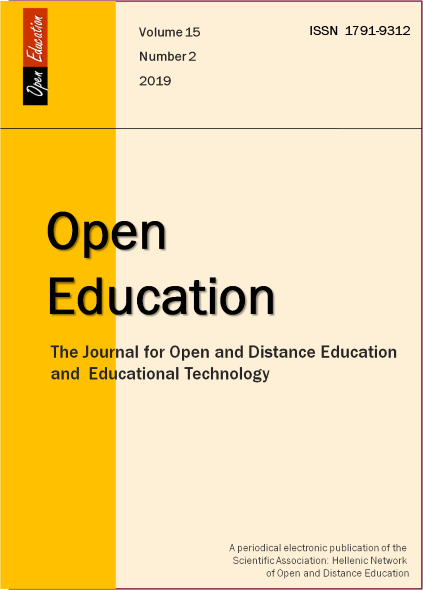Ο ΡΟΛΟΣ ΤΩΝ ΜΕΣΩΝ ΚΟΙΝΩΝΙΚΗΣ ΔΙΚΤΥΩΣΗΣ ΣΤΗ ΣΥΝΕΡΓΑΤΙΚΗ ΜΑΘΗΣΗ ΚΑΙ ΣΤΗΝ ΕΠΙΔΟΣΗ ΦΟΙΤΗΤΩΝ ΕΞ ΑΠΟΣΤΑΣΕΩΣ ΕΚΠΑΙΔΕΥΣΗΣ

Περίληψη
Τα Μέσα Κοινωνικής Δικτύωσης χρησιμοποιούνται συχνά για εκπαιδευτικούς σκοπούς. Η παρούσα έρευνα εξετάζει με ποιους τρόπους η συμμετοχή των φοιτητών σε Μέσα Κοινωνικής Δικτύωσης επηρεάζει την άτυπη συνεργατική μάθηση στην Τριτοβάθμια Ανοικτή και εξ Αποστάσεως Εκπαίδευση και τη συμβολή της στην ακαδημαϊκή επίδοση. Βασίζεται στη σύνδεση του πλαισίου για την αλληλεπίδραση και τη γνωστική εμπλοκή σε πλαίσιο connectivist μάθησης των Wang, Chen & Anderson με τα τέσσερα κριτήρια για τη συνεργατική μάθηση του Dillenbourg και χρήση Μέσων Κοινωνικής Δικτύωσης. Χορηγήθηκε ψηφιακό ερωτηματολόγιο σε φοιτητές κλειστής ομάδας στο Facebook και διενεργήθηκαν ημιδομημένες συνεντεύξεις. Η αλληλεπίδραση που αναπτύσσεται μέσω Μέσων Κοινωνικής Δικτύωσης, σύμφωνα με το πλαίσιο των Wang, Chen & Anderson, επιδρά ανάλογα στη συνεργατική μάθηση, σύμφωνα με τα κριτήρια του Dillenbourg. Η αλληλεπίδραση και η συνεργασία οδηγούν σε καλύτερα μαθησιακά αποτελέσματα. Η συνεργασία μέσω Μέσων Κοινωνικής Δικτύωσης ενισχύει την ατομική επίδοση, παρά τη μεγάλη μεταβλητότητα, καθώς και την επίδοση της ομάδας. Η πλειοψηφία των συμμετεχόντων φοιτητών προτιμά να συνεργάζεται για την εκπόνηση των εργασιών και εκφράζει την πρόθεσή της για επικοινωνία και για συνεργατική μάθηση μέσω Μέσων Κοινωνικής Δικτύωσης.
Λεπτομέρειες άρθρου
- Πώς να δημιουργήσετε Αναφορές
-
- Τεύχος
- Τόμ. 15 Αρ. 2 (2019)
- Ενότητα
- Μέρος πρώτο / Section 1


